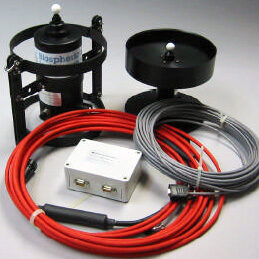BSI’s PNF Natural Fluorometers are integrated optical systems specifically designed to measure natural fluorescence — the fluorescence from the phytoplankton crop stimulated by available sunlight. Starting with research conducted at BSI under a NASA SBIR contract and followed on with considerable additional studies has shown that this measurement is related to photosynthetic rates and chlorophyll concentrations. Unlike strobe fluorometers, a natural fluorometer measures fluorescence emitted under the ambient light conditions that are driving photosynthesis in situ.
Features
Measurement: Vertical profiles and logging of scalar irradiance (E0PAR) at depth and at the surface, upwelling (nadir) red radiance (LuChl), water temperature, and pressure/depth. Enables calculation of estimated values including photosynthetic rates, volume fluorescence, and chlorophyll concentration.
Spectral Response: Scalar irradiance E0PAR with 400–700 nm spectral response. Upwelling radiance LuChl covering the chlorophyll emission spectrum with spectral response centered at 683 nm.
Small and lightweight.
Direct connection to PC USB port for power and data.
RS232 output and low power requirement make the sensors compatible with data loggers.
References
Kiefer, D.A., W.S. Chamberline, and C.R. Booth (1989). Natural fluorescence of chlorophyll a: Relationship to photosynthesis and chlorophyll concentration in the western South Pacific gyre. Limnol. Oceanogr., 34(5), 868–881.
Chamberlin, W.S., C.R. Booth, D.A. Kiefer, J.H. Morrow, and R.C. Murphy (1990). Evidence for a simple relationship between natural fluorescence, photosynthesis, and chlorophyll in the sea. Deep-Sea Research, 37(6), 951–973.

